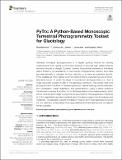Files in this item
PyTrx : a python-based monoscopic terrestrial photogrammetry toolset for glaciology
Item metadata
| dc.contributor.author | How, Penelope | |
| dc.contributor.author | Hulton, Nicholas R. J. | |
| dc.contributor.author | Buie, Lynne | |
| dc.contributor.author | Benn, Douglas I. | |
| dc.date.accessioned | 2020-02-19T17:30:02Z | |
| dc.date.available | 2020-02-19T17:30:02Z | |
| dc.date.issued | 2020-02-13 | |
| dc.identifier | 266468242 | |
| dc.identifier | 34a5f64d-430c-4822-a4e0-40b19b82d996 | |
| dc.identifier | 000517447500001 | |
| dc.identifier | 85085247923 | |
| dc.identifier.citation | How , P , Hulton , N R J , Buie , L & Benn , D I 2020 , ' PyTrx : a python-based monoscopic terrestrial photogrammetry toolset for glaciology ' , Frontiers in Earth Science , vol. 8 , 21 . https://doi.org/10.3389/feart.2020.00021 | en |
| dc.identifier.issn | 2296-6463 | |
| dc.identifier.other | RIS: urn:830714242341E6B8C7CDB7406F564EB5 | |
| dc.identifier.other | ORCID: /0000-0002-3604-0886/work/69463212 | |
| dc.identifier.uri | https://hdl.handle.net/10023/19499 | |
| dc.description | This work was affiliated with the CRIOS project (Calving Rates and Impact On Sea Level), which was supported by the Conoco Phillips-Lundin Northern Area Program. PH was funded by a NERC Ph.D. studentship (reference number 1396698). | en |
| dc.description.abstract | Terrestrial time-lapse photogrammetry is a rapidly growing method for deriving measurements from glacial environments because it provides high spatio-temporal resolution records of change. Currently, however, the potential usefulness of time-lapse data is limited by the unavailability of user-friendly photogrammetry toolsets. Such data are used primarily to calculate ice flow velocities or to serve as qualitative records. PyTrx (available at https://github.com/PennyHow/PyTrx) is presented here as a Python-alternative toolset to widen the range of monoscopic photogrammetry (i.e., from a single viewpoint) toolsets on offer to the glaciology community. The toolset holds core photogrammetric functions for template generation, feature-tracking, camea calibration and optimization, image registration, and georectification (using a planar projective transformation model). In addition, PyTrx facilitates areal and line measurements, which can be detected from imagery using either an automated or manual approach. Examples of PyTrx's applications are demonstrated using time-lapse imagery from Kronebreen and Tunabreen, two tidewater glaciers in Svalbard. Products from these applications include ice flow velocities, surface areas of supraglacial lakes and meltwater plumes, and glacier terminus profiles. | |
| dc.format.extent | 17 | |
| dc.format.extent | 2310976 | |
| dc.language.iso | eng | |
| dc.relation.ispartof | Frontiers in Earth Science | en |
| dc.subject | Glacier dynamics | en |
| dc.subject | Photogrammetry | en |
| dc.subject | Python | en |
| dc.subject | Tidewater glaciers | en |
| dc.subject | Time-lapse | en |
| dc.subject | G Geography (General) | en |
| dc.subject | DAS | en |
| dc.subject.lcc | G1 | en |
| dc.title | PyTrx : a python-based monoscopic terrestrial photogrammetry toolset for glaciology | en |
| dc.type | Journal article | en |
| dc.contributor.institution | University of St Andrews. School of Geography & Sustainable Development | en |
| dc.contributor.institution | University of St Andrews. Bell-Edwards Geographic Data Institute | en |
| dc.identifier.doi | 10.3389/feart.2020.00021 | |
| dc.description.status | Peer reviewed | en |
This item appears in the following Collection(s)
Items in the St Andrews Research Repository are protected by copyright, with all rights reserved, unless otherwise indicated.

